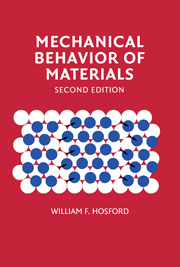Book contents
- Frontmatter
- Contents
- Preface
- 1 Stress and Strain
- 2 Elasticity
- 3 Mechanical Testing
- 4 Strain Hardening of Metals
- 5 Plasticity Theory
- 6 Strain Rate and Temperature Dependence of Flow Stress
- 7 Slip and Crystallographic Textures
- 8 Dislocation Geometry and Energy
- 9 Dislocation Mechanics
- 10 Mechanical Twinning and Martenitic Shear
- 11 Hardening Mechanisms in Metals
- 12 Discontinuous and Inhomogeneous Deformation
- 13 Ductility and Fracture
- 14 Fracture Mechanics
- 15 Viscoelasticity
- 16 Creep and Stress Rupture
- 17 Fatigue
- 18 Residual Stresses
- 19 Ceramics and Glasses
- 20 Polymers
- 21 Composites
- 22 Mechanical Working
- APPENDIX I Miller Indices
- APPENDIX II Stereographic Representation of Orientations
- Index
10 - Mechanical Twinning and Martenitic Shear
Published online by Cambridge University Press: 05 June 2012
- Frontmatter
- Contents
- Preface
- 1 Stress and Strain
- 2 Elasticity
- 3 Mechanical Testing
- 4 Strain Hardening of Metals
- 5 Plasticity Theory
- 6 Strain Rate and Temperature Dependence of Flow Stress
- 7 Slip and Crystallographic Textures
- 8 Dislocation Geometry and Energy
- 9 Dislocation Mechanics
- 10 Mechanical Twinning and Martenitic Shear
- 11 Hardening Mechanisms in Metals
- 12 Discontinuous and Inhomogeneous Deformation
- 13 Ductility and Fracture
- 14 Fracture Mechanics
- 15 Viscoelasticity
- 16 Creep and Stress Rupture
- 17 Fatigue
- 18 Residual Stresses
- 19 Ceramics and Glasses
- 20 Polymers
- 21 Composites
- 22 Mechanical Working
- APPENDIX I Miller Indices
- APPENDIX II Stereographic Representation of Orientations
- Index
Summary
Introduction
Most crystals can deform by twinning. Twinning is particularly important in hcp metals because hcp metals do not have enough easily activated slip systems to produce an arbitrary shape change.
Mechanical twinning, like slip, occurs by shear. A twin is a region of a crystal in which the orientation of the lattice is a mirror image of that in the rest of the crystal. Normally, the boundary between the twin and the matrix lies in or near the mirror plane. Twins may form during recrystallization (annealing twins), but the concern here is formation of twins by uniform shearing (mechanical twinning), as illustrated in Figure 10.1. In this figure, plane 1 undergoes a shear displacement relative to plane 0 (the mirror plane). Then plane 2 undergoes the same shear relative to plane 1, and plane 3 relative to plane 2, and so on. The net effect of the shear between each successive plane is to reproduce the lattice, but with the new (mirror image) orientation.
Both slip and twinning are deformation mechanisms that involve shear displacements on specific crystallographic planes and in specific crystallographic directions. However, there are important differences.
With slip, the magnitude of the shear displacement on a plane is variable, but it is always an integral number of interatomic repeat distances, nb, where b is the Burgers vector. Slip occurs on only a few of the parallel planes separated by relatively large distances. With twinning, on the other hand, the shear displacement is a fraction of an interatomic repeat distance, and every atomic plane shears relative to its neighboring plane.
[…]
- Type
- Chapter
- Information
- Mechanical Behavior of Materials , pp. 166 - 183Publisher: Cambridge University PressPrint publication year: 2009



